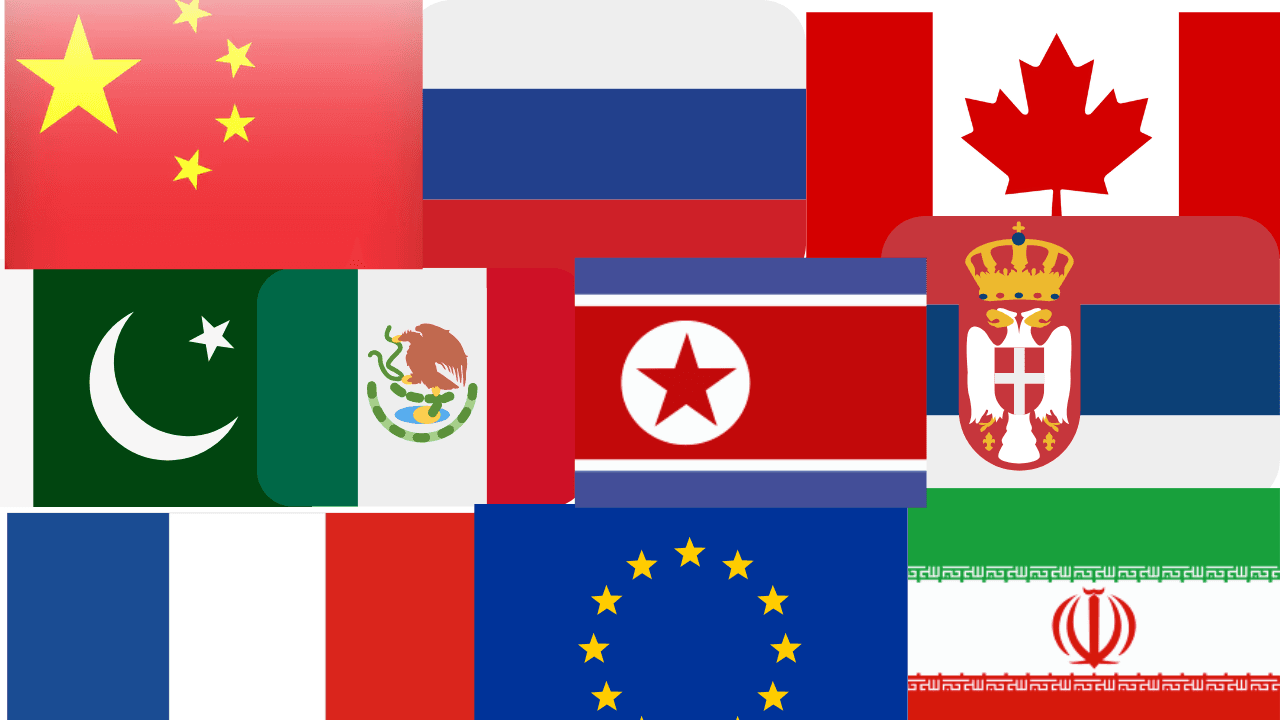10 Countries Affected by U.S. Bans and Sanctions in 2025

Introduction
The U.S. has imposed new bans, sanctions, and trade restrictions on several countries in 2025, including the focus keyword: U.S. Bans and Sanctions. Among the most affected nations are China, Pakistan, France, Canada, Mexico, the European Union (EU), Serbia, Iran, Russia, and North Korea. These U.S. bans and sanctions, driven by economic and security concerns, are shaping global trade policies and international relations. Let’s explore how these restrictions impact each country and what it means for businesses and global markets.

1. China – Trade War and Tech Sanctions
Key U.S. Actions:
- The U.S. blacklisted over 50 Chinese companies, including major AI and semiconductor firms.
- Tariffs on Chinese imports increased from 10% to 20% in March 2025.
- Investment restrictions placed on American businesses funding Chinese tech industries.
- The U.S. targeted Shouguang Luqing Petrochemical for violating Iranian oil trade sanctions.
Impact on China:
The U.S. Bans and Sanctions on China are part of an escalating trade war that has been ongoing for years. By targeting AI, semiconductor, and energy companies, the U.S. aims to limit China’s technological advancement and global economic influence.
- The semiconductor industry faces severe supply chain disruptions, affecting major companies like Huawei, SMIC, and ByteDance.
- Tech investments slow down, with foreign investors hesitant to fund Chinese startups.
- The Chinese economy sees a decline in exports, especially in electronics and machinery.
- Many Chinese manufacturers are relocating operations to Southeast Asia to bypass U.S. tariffs.
- The Chinese government is investing heavily in domestic semiconductor production to reduce reliance on American technology.
China has responded by imposing its own tariffs on American goods, targeting industries like agriculture, automotive, and consumer electronics. This tit-for-tat strategy is increasing global economic instability.

2. Pakistan – Military and Nuclear-Related Sanctions
Key U.S. Actions:
- Several Pakistani entities were blacklisted for their alleged involvement in nuclear and drone technology.
- The U.S. imposed restrictions on Pakistani defense imports, affecting military modernization.
- Technology sector targeted, with bans on firms accused of links with China and Iran.
- Economic restrictions on Pakistani banks, limiting international financial transactions.
Impact on Pakistan:
U.S. bans and sanctions have taken effect on multiple countries. U.S. Bans and Sanctions on Pakistan has faced multiple rounds of sanctions over the years, but the 2025 sanctions are particularly damaging due to their impact on the country’s defense and technology sectors.
- The defense sector suffers due to restricted access to U.S. military technology, making it harder for Pakistan to modernize its armed forces.
- The technology industry struggles as companies face challenges in acquiring advanced components.
- Foreign investment in Pakistan declines, with companies fearing instability.
- Exports to the U.S. are affected, particularly in textiles, one of Pakistan’s largest export industries.
- Diplomatic relations between Pakistan and the U.S. become strained, leading to increased collaboration between Pakistan and China.
In response, Pakistan is strengthening trade ties with China, Turkey, and Russia, focusing on diversifying its economy away from Western dependencies.

3. France – Potential Trade Restrictions
Key U.S. Actions:
- The U.S. hinted at new tariffs on French luxury goods, automobiles, and aerospace exports.
- French tech firms could face regulatory scrutiny over data privacy and competition laws.
- The U.S. threatened higher tariffs on wine, cheese, and fashion exports.
Impact on France:
The U.S. has been at odds with France over various economic and policy disagreements, especially in the digital tax and aerospace industries.
- Luxury brands like Louis Vuitton, Chanel, and Hermès could see a decline in U.S. sales if tariffs increase.
- The French automotive industry, including Renault and Peugeot, faces new challenges in the American market.
- The Airbus vs. Boeing trade war intensifies, with the U.S. seeking to limit Airbus’s market share.
- French wine and cheese exports face higher tariffs, leading to losses for small producers.
- France is considering retaliatory tariffs on American tech companies like Apple, Google, and Microsoft, further straining relations.
Despite these tensions, France is strengthening economic ties with China and Middle Eastern nations to reduce reliance on American trade.

4. Canada – Heavy Tariffs on Trade
Key U.S. Actions:
- A 25% tariff imposed on all Canadian goods, except energy, which faces a 10% tariff.
- Increased trade restrictions on Canadian lumber and dairy products.
- The U.S. is pressuring Canada to reduce ties with China in the tech and energy sectors.
Impact on Canada:
U.S. bans and sanctions have taken effect on multiple countries. Canada has long been one of the U.S.’s closest trade partners, but recent tariffs have caused friction.
- The agriculture and manufacturing sectors are hit hard, with dairy, beef, and lumber exports facing new restrictions.
- Higher prices for American consumers buying Canadian goods like timber and oil.
- Canada is considering retaliatory tariffs, which could impact American exports of automobiles and agricultural products.
- The Canadian government is negotiating new trade deals with the European Union and Asia to reduce its dependence on the U.S. market.
- The energy industry is seeing shifts, with Canada exploring alternative buyers for its oil and natural gas.

5. Mexico – Trade Tariffs and Border Control Policies
Key U.S. Actions:
- Increased tariffs on Mexican steel and automotive parts.
- Stricter border control policies affecting trade and migrant labor.
- New sanctions on Mexican firms linked to drug cartels and money laundering.
- Ban on certain agricultural exports due to environmental and safety concerns.
Impact on Mexico:
U.S. Bans and Sanctions in 2025: A Closer Look
The new trade barriers and tariffs are affecting Mexico’s largest industries:
- Automotive sector faces increased costs, with companies like General Motors and Ford shifting some production.
- Agricultural exports decline, impacting Mexican farmers exporting avocados, tomatoes, and beef.
- Manufacturing jobs are at risk as U.S. companies consider shifting production to other regions.
- The Mexican peso fluctuates, leading to economic uncertainty.
Mexico is responding by negotiating new trade agreements with China, Canada, and South American nations to reduce dependency on the U.S. market.

6. European Union (EU) – Digital and Economic Disputes
Key U.S. Actions:
- Tariffs imposed on European steel, aluminum, and luxury goods.
- Regulatory restrictions on European digital companies, such as GDPR compliance conflicts with U.S. policies.
- Sanctions on EU firms dealing with Russia and Iran, limiting European trade flexibility.
Impact on the EU:
U.S. bans and sanctions have taken effect on multiple countries.. The EU, one of the U.S.’s biggest economic partners, is facing challenges due to these sanctions:
- Tech giants like SAP and Nokia face hurdles in operating within U.S. regulatory frameworks.
- European carmakers like BMW, Volkswagen, and Renault see higher export costs, affecting global sales.
- Luxury brands, including Louis Vuitton and Gucci, face increased tariffs, reducing profitability in the U.S. market.
- EU retaliates with digital taxes on American companies like Amazon, Apple, and Google.
In response, EU nations are strengthening trade agreements with Asia and Middle Eastern markets to offset losses.

7. Serbia – Military and Political Sanctions
Key U.S. Actions:
- Sanctions on Serbian military purchases from Russia and China.
- Travel bans on Serbian officials accused of human rights violations.
- Economic restrictions on Serbian banks linked to money laundering allegations.
Impact on Serbia:
U.S. bans and sanctions have taken effect on multiple countries. The U.S. measures are affecting Serbia’s political and military alliances:
- Defense procurement from Russia and China is halted, delaying military modernization.
- Serbian exports to the U.S. face hurdles, particularly in agriculture and IT services.
- Foreign investments in Serbia decline, especially from Western businesses.
- Serbia strengthens ties with Russia, China, and Middle Eastern economies to counterbalance restrictions.

8. Iran – Continued Economic and Oil Sanctions
Key U.S. Actions:
- New restrictions on Iranian oil exports, targeting companies violating previous sanctions.
- Financial sanctions on Iranian banks, making international transactions difficult.
- Ban on U.S. technology and software exports to Iran, limiting tech growth.
- Sanctions on Iranian officials involved in nuclear programs and military actions.
Impact on Iran:
U.S. bans and sanctions have taken effect on multiple countries. Iran has been under U.S. sanctions for decades, but the 2025 restrictions tighten economic pressure:
- Oil revenue drops as fewer countries are willing to buy Iranian crude due to U.S. pressure.
- Technology and infrastructure development slows down, affecting economic growth.
- Higher inflation and unemployment rates, leading to internal economic challenges.
- Iran seeks closer economic cooperation with China, Russia, and Venezuela to bypass U.S. sanctions.
Despite the sanctions, Iran continues expanding its regional influence, maintaining trade networks with non-Western allies.

9. Russia – Energy, Defense, and Financial Sanctions
Key U.S. Actions:
- Sanctions on Russian oil and gas exports, restricting global energy sales.
- Ban on American companies investing in Russian infrastructure and technology.
- Financial restrictions on Russian banks, limiting international transactions.
- Expanded arms embargo, restricting Russian defense exports.
Impact on Russia:
U.S. bans and sanctions have taken effect on multiple countries.. The U.S. aims to weaken Russia’s economy, but the sanctions come with consequences:
- Russian oil and gas exports shift towards Asia, particularly China and India.
- Defense industries face limitations, as access to Western components is restricted.
- Financial markets experience volatility, impacting the Russian ruble.
- Moscow increases trade with BRICS nations (Brazil, India, China, South Africa) to counteract Western measures.

10. North Korea – Total Economic Isolation
Key U.S. Actions:
- Expanded economic sanctions, cutting off North Korea’s access to global markets.
- Ban on financial transactions involving North Korean banks.
- Restrictions on Chinese firms suspected of dealing with North Korea.
- More aggressive enforcement of UN-led sanctions.
Impact on North Korea:
U.S. bans and sanctions have taken effect on multiple countries. North Korea is already heavily sanctioned, and these new measures further isolate the country:
- Severe food shortages and economic struggles worsen due to reduced trade.
- Black market trade increases, with more underground dealings with China and Russia.
- Nuclear program development continues, despite global pressure.
- Pyongyang seeks stronger alliances with Iran, Venezuela, and African nations for economic survival.
Overall, the U.S. bans and sanctions are a critical factor in shaping the future of global trade, compelling nations to adapt and innovate in their economic strategies.
Future Outlook and Global Trade Impact
The U.S. sanctions and trade bans in 2025 have created significant disruptions in global trade. As countries look for alternative partnerships, the international economic landscape is undergoing major shifts:
- China is strengthening economic alliances with Russia, Iran, and developing nations to counterbalance U.S. restrictions on technology and trade.
- Pakistan is diversifying its trade partnerships, deepening cooperation with China under CPEC while seeking investment from Middle Eastern and Southeast Asian countries.
- France is leading EU efforts to retaliate against U.S. tariffs by imposing new taxes on American tech companies and seeking stronger ties with Asian markets.
- Canada is focusing on strengthening trade with Europe and Asia while negotiating exemptions for key industries affected by U.S. restrictions.
- Mexico is expanding its trade agreements with China, South America, and the EU to reduce reliance on the U.S. market, particularly in manufacturing and agriculture.
- The European Union (EU) is pursuing greater economic independence from the U.S. by developing digital sovereignty policies and boosting intra-European trade.
- Serbia is reinforcing ties with Russia and China for military and economic cooperation while maintaining diplomatic channels with the EU.
- Iran is deepening economic integration with non-Western allies like China, Russia, and Venezuela to bypass U.S. sanctions on oil and financial transactions.
- Russia is redirecting its energy exports to Asia and Africa, solidifying trade agreements with BRICS nations to counteract Western economic measures.
- North Korea is increasing its underground trade with China and Russia while further developing its self-sustaining economic model amid total U.S. isolation.
Conclusion
The evolving landscape of U.S. sanctions and trade restrictions is reshaping global alliances. While the U.S. seeks to curb economic and security threats, affected nations are actively developing alternative trade routes and economic strategies. The shift in global trade dynamics signals the rise of regional economic blocs and increased cooperation among sanctioned countries. As international relations continue to change, businesses, governments, and investors must adapt to the new geopolitical and economic order.
Staying informed about policy changes and emerging trade partnerships will be crucial for navigating the uncertainties of the global economy in 2025 and beyond.
Sources & References
To ensure credibility and provide readers with trusted information, here are key sources that support this analysis:
- U.S. Sanctions Programs and Country Information – Official U.S. government page detailing active sanctions programs.
- Iran Sanctions – U.S. Department of State – Overview of economic and trade restrictions imposed on Iran.
- International Emergency Economic Powers Act (IEEPA) – Legal framework for U.S. economic sanctions.
- European Union Sanctions Policy – EU’s approach to sanctions and international trade policies.
- CEPR Sanctions Watch – February 2025 – Analysis of the latest economic measures impacting global trade.
- Weekly Sanctions Update: February 10, 2025 – Recent updates on U.S. sanctions against multiple countries.
- Trump Tariffs on Venezuela Crude Buyers – Overview of tariffs imposed on countries purchasing Venezuelan crude oil.
- EU’s 16th Package of Sanctions – European Union’s latest sanctions against Russia.
- Serbia’s Main Gas Supplier Faces U.S. Sanctions – U.S. actions against Serbia’s gas supply chain.
- Canada’s Economic Statecraft Strategy – How Canada is adapting to global trade disruptions.
These references provide further insights into the geopolitical and economic implications of recent sanctions and trade restrictions. Readers are encouraged to explore these links for in-depth knowledge and updates on the topic.
In light of the U.S. bans and sanctions, nations around the globe are reassessing their trade strategies, recognizing the need for diversification and resilience in the face of economic pressures.



